
Art Nouveau is an international style of art, architecture and applied art, especially the decorative arts, that was most popular between 1890 and 1910. A reaction to the academic art of the 19th century, it was inspired by natural forms and structures, particularly the curved lines of plants and flowers.
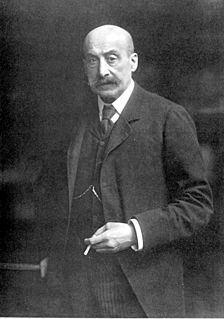
Max Liebermann was a German painter and printmaker of Ashkenazi Jewish ancestry, and one of the leading proponents of Impressionism in Germany.

Lovis Corinth was a German artist and writer whose mature work as a painter and printmaker realized a synthesis of impressionism and expressionism.

Arnold Böcklin was a Swiss symbolist painter.

Max Slevogt was a German Impressionist painter and illustrator, best known for his landscapes. He was, together with Lovis Corinth and Max Liebermann, one of the foremost representatives in Germany of the plein air style.

Allach porcelain a.k.a. Porzellan Manufaktur Allach was produced in Germany between 1935 and 1945. After its first year of operation, the enterprise was run by the SS with forced labor provided by the Dachau concentration camp. The emphasis was on decorative ceramics —objects d'art for the Nazi regime. The company logo included stylized SS runes. Sometimes in place of the company name, the pottery markings mentioned the SS: "DES - WIRTSCHAFTS - VERWALTUNGSHAUPTAMTES".
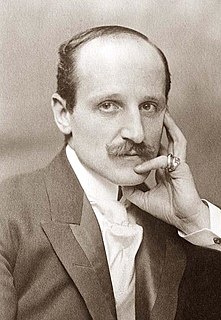
Adolfo Müller-Ury, KSG was a Swiss-born American portrait painter and impressionistic painter of roses and still life.

Markus Lüpertz is a German painter, sculptor, graphic artist and writer. He also publishes a magazine, and plays jazz piano. He is one of the best-known German contemporary artists. His subjects are characterized by suggestive power and archaic monumentality. Lüpertz insists on capturing the object of representation with an archetypal statement of his existence. His art work is associated to neo-expressionism. Known for his excentricity, German press has stylized him as a "painter prince".

The Nymphenburg Porcelain Manufactory, manufacturer of Nymphenburg porcelain, is situated next to the Nymphenburg Palace in Munich, capital of Bavaria, and since the mid-eighteenth century has been manufacturing porcelain of high artistic value.

Hans Grundig was a German painter and graphic artist associated with the New Objectivity movement.
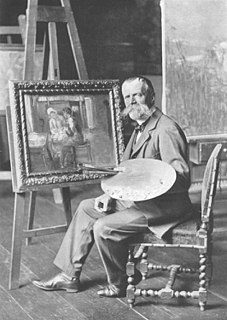
Fritz von Uhde was a German painter of genre and religious subjects. His style laying between Realism and Impressionism, he was once known as "Germany's outstanding impressionist" and he became one of the first painters who introduced en plein air art in his country.

Matteo Sandonà (1881–1964) was a painter born in Schio, Italy and raised in the Alps. He immigrated with his family to New Jersey in 1894. Two years later he returned to Europe for four years of study at the Academy of Fine Arts, Verona and in Paris under Napoleone Nani and Mose Bianchi. After returning to the United States, he took further training at the National Academy of Design. In 1901, he and his father settled in San Francisco. Sandonà co-founded the California Society of Artists in 1901. In 1903, he made the first of several trips to Hawaii, where he painted portraits of the territory’s elite.

Richard Riemerschmid was a German architect, painter, designer and city planner from Munich. He was a major figure in Jugendstil, the German form of Art Nouveau, and a founder of architecture in the style. A founder member of both the Vereinigte Werkstätte für Kunst im Handwerk and the Deutscher Werkbund and the director of art and design institutions in Munich and Cologne, he prized craftsmanship but also pioneered machine production of artistically designed objects.
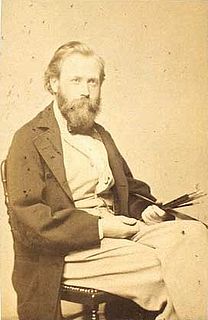
Ole Henrik Benedictus Olrik was a Danish painter, sculptor and applied artist.

Franz Anton Bustelli was a Swiss-born German modeller for the Bavarian Nymphenburg Porcelain Manufactory from 1754 to his death in 1763. He is widely regarded as the finest modeller of porcelain in the Rococo style: "if the art of European porcelain finds its most perfect expression in the rococo style, so the style finds its most perfect expression in the work of Bustelli".
Alfred Heinrich Pellegrini was a Swiss painter, illustrator and printmaker. Along with Heinrich Altherr, Paul Bodmer and Walter Clénin, he was one of the most prolific Swiss muralists of the first half of the twentieth century.

Karl Ballenberger (1801–1860) was a 19th-century German painter who worked in an archaic, medievalising style.
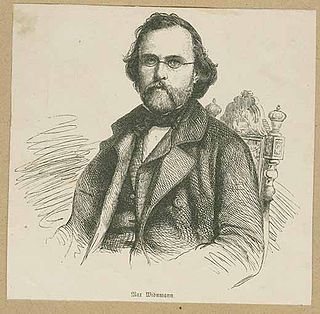
Max von Widnmann was a German sculptor and professor at the Academy of Fine Arts in Munich. Many of his works were commissioned by King Ludwig I of Bavaria.

Emil Fuchs, MVO, was an Austrian and American sculptor, medallist, painter, and author who worked in Vienna, London and New York. He painted portraits of Queen Victoria and Edward VII and was fashionable among London high society in the early 20th century.

Hedvig Erika ("Vicken") von Post Börjeson Totten was a Swedish ceramicist, sculptor, painter, and illustrator.






















